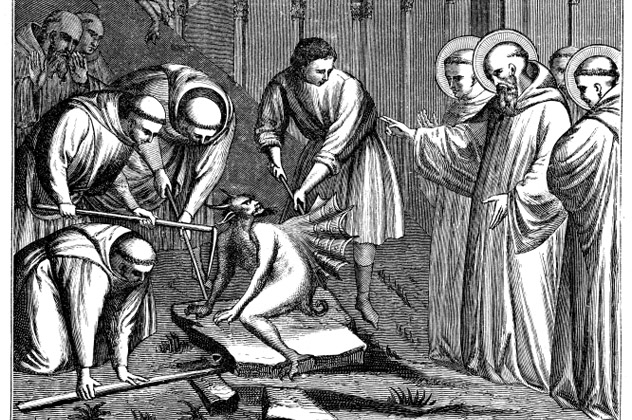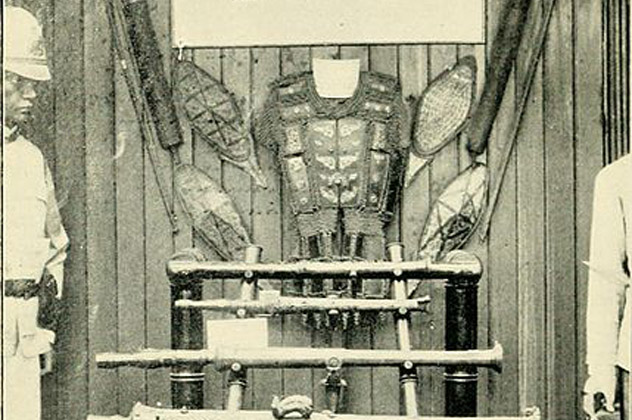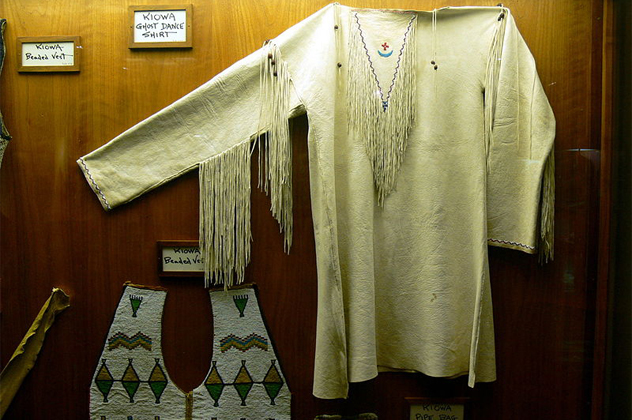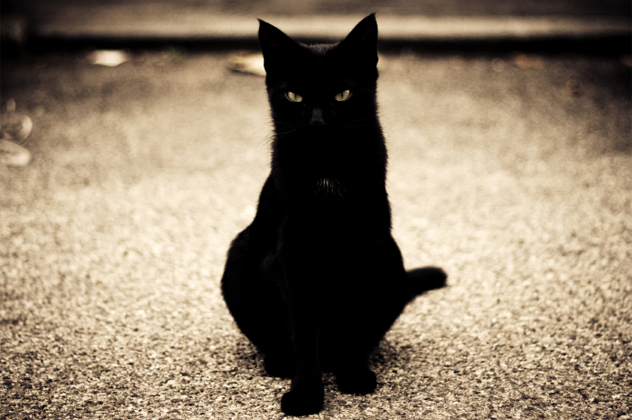 Weird Stuff
Weird Stuff  Weird Stuff
Weird Stuff  Mysteries
Mysteries 10 Tragic Disappearances and Deaths in Joshua Tree National Park
 History
History 10 Ways Childhood Really Sucked in the Old West
 Music
Music 10 Name Origins of Famous Bands from the 1990s
 Religion
Religion 10 Biggest Turnarounds by the Catholic Church
 Weird Stuff
Weird Stuff 10 Unbelievable Times Laws Had Unintended Consequences
 Humans
Humans Ten Historic Women Who Deserve Way More Credit Than They Got
 Movies and TV
Movies and TV 10 Films That Spawned Major Lawsuits
 History
History Ten Times Towns Were Wiped Off the Face of the Earth
 Creepy
Creepy 10 of the Most Disturbingly Haunted Public Houses in the UK
 Weird Stuff
Weird Stuff 10 Niche Subcultures That Are More Popular Than You Might Think
 Mysteries
Mysteries 10 Tragic Disappearances and Deaths in Joshua Tree National Park
 History
History 10 Ways Childhood Really Sucked in the Old West
Who's Behind Listverse?

Jamie Frater
Head Editor
Jamie founded Listverse due to an insatiable desire to share fascinating, obscure, and bizarre facts. He has been a guest speaker on numerous national radio and television stations and is a five time published author.
More About Us Music
Music 10 Name Origins of Famous Bands from the 1990s
 Religion
Religion 10 Biggest Turnarounds by the Catholic Church
 Weird Stuff
Weird Stuff 10 Unbelievable Times Laws Had Unintended Consequences
 Humans
Humans Ten Historic Women Who Deserve Way More Credit Than They Got
 Movies and TV
Movies and TV 10 Films That Spawned Major Lawsuits
 History
History Ten Times Towns Were Wiped Off the Face of the Earth
 Creepy
Creepy 10 of the Most Disturbingly Haunted Public Houses in the UK
10 Charms And Talismans With Unsettling Histories
As a whole, mankind is a superstitious lot. The world is a cruel place and we need all the help we can get. So, what do we do? We turn to our amulets and charms, our talismans, and sometimes, even our animals with the hope that a little good luck will protect us from whatever’s out there. However, some of those charms have a pretty unsettling story.
10The Medal Of Saint Benedict

On one side of the medal is the cross of Saint Benedict and an incantation recited to drive away the devil. The letters around the outside of the medal (V.R.S.N.S.M.V.) stand for “Vade retro Satana; nunquam suade mihi vana.” In English, that translates to “Begone Satan! Suggest not to be they vain things.”
Saint Benedict’s teachings have been around for centuries, recorded most completely in the sixth-century writings of Saint Gregory the Great. But the incantation that adorns his medal came much later, and was discovered during a trial for witchcraft. In 1647, a group of women were on trial for witchcraft in the Bavarian city of Natternberg. The women testified that while they did wield the power of witchcraft and the devil, there was one place where they had no power . . . the nearby abbey at Metten. The women claimed the abbey was under some sort of particularly powerful protection, and they were unable to overcome whatever it was.
When the abbey was investigated to find out why it had kept the witches away, the townsfolk actually found something. Painted crosses hung on the walls of the abbey with the same inscription that’s now used on the medal. There was no clue what the letters stood for until they uncovered a manuscript dated from 1415. The manuscript depicted an illumination of the saint holding a scroll and a staff. On that scroll and staff was the entire incantation that’s now associated with Benedict.
The incantation that had stifled the witches’ power went 17th-century viral, and medals stamped with the letters spread across the continent. They became known as being incredibly effective against anyone suffering from demonic possession. They were also believed to give the wearer divine protection, help drive away anything evil, and ultimately bring about peace of mind and a pure heart.
9Anting-Anting

Legends of the Anting-Anting come from the Philippines. It was believed that the amulet protected the wearer from any harm done by bullets or knives and became popular among the county’s outlaws. In his treatise on folklore, John Maurice Miller told the story of Manuelito—the leader of an outlaw band who was kept safe by his Anting-Anting.
According to the story, Manuelito had countless run-ins with the law, and every time, he would walk away. It was said that it didn’t matter how many people were shooting at him, his Anting-Anting would deflect any bullets that even came close to him. During parties and celebrations, he would arm his own men and instruct them to shoot at him, all to demonstrate his invincibility. As the outlaw and his men approached Manila, a group of Macabebes were dispatched to try to put an end to his reign of terror once and for all. They cast their bullets from silver that was melted from a statue of the Virgin Mary. It was the only thing powerful enough to overcome the Anting-Anting and, finally, kill the outlaw leader.
Copies of Manuelito’s charm were made in huge numbers, but the folklore behind making an Anting-Anting is pretty terrible. It was most effective when they were made during Holy Week. One method called for the exhumation of an unbaptized child or an aborted baby. The body was placed inside a bamboo tube, and the liquid that drained from the tube was collected. Then, the fluid was slowly sipped by whoever wanted to gain the protection of the Anting-Anting. Alternately, they could head to a cemetery during Holy Week and place an offering of food and wine on a tomb. Spirits would consume the meal and leave behind a white stone, giving their protection in exchange for the meal.
8Chimney Sweeps

Superstitions and beliefs have grown around one of the most unlikely occupations—the chimney sweep. In Germany, seeing a chimney sweep around the new year was considered a sign of good things to come in the next year. Several countries, such as Germany and England, use trinkets and edible delights in the shape of sweeps and tools of the trade as good luck charms. In England, including a chimney sweep on your wedding guest list is a guaranteed way to bring luck and fertility. Many modern chimney sweeps hire themselves out for weddings for the continuation of a practice that’s been going strong since the rule of King George II.
According to traditional lore, English chimney sweeps enjoy their reputation as a lucky charm because of one unnamed sweep who saved King George II. One version of the story says the king was riding his horse when his mount was spooked by a dog, and a chimney sweep stepped in to save the day. In another version, the king was in the carriage, but the outcome is the same. The sweep was officially recognized as a lucky sort of chap to have around.
However, those who were forced to be Victorian-era chimney sweeps were about as unlucky as you could get. Young boys that were small enough to fit into the chimneys were apprenticed under a master sweeper. By the 1870s, the newspapers were filled with instances of master sweepers receiving guilty verdicts on manslaughter charges. In February 1875, a Cambridge sweep was found guilty for the death of a boy he had forced to climb up a flue at Fulborn Asylum. Once the boy emerged, he suffocated on soot.
Folklore of a different sort was also used to frighten children. Naughty kids were warned that the chimney sweep would come, stuff them in a sack, and take them up the chimney if they didn’t behave.
7Horseshoes

Whether it’s hung on a wall to keep and collect all the good luck or to spill out on everyone who passes, the horseshoe is a common superstition. One explanation of how it came to be lucky is the dark tale of Saint Dunstan, a holy man who worked a blacksmith’s forge when he wasn’t occupied by prayer or playing his harp.
According to the story, Saint Dunstan was doing the latter when the devil heard him singing. The song filled the devil with hate, and he, too, began to sing. The devil caused such a horrible noise that Dunstan knew it was only made by something truly evil. Dunstan seized him by the nose with a pair of pliers hot from the forge and proceeded to fix hot iron shoes on the devil’s feet and drive the nails through the soft skin. The screams of agony were loud enough to wake the dead.
Dunstan refused to remove the shoes and nails until the devil signed a contract promising to never bother people while they were praying in church or anywhere under the protection of a horseshoe. Dunstan kept up his end of the deal, and ever since, the horseshoe has protected anyone who hangs it up . . . as long as they remain virtuous.
There are a couple of other explanations about the horseshoe, including the association with the number seven (the usual amount of nails used). Oddly enough, the blacksmith was typically associated with evil rather than good. While the blacksmith was linked to the practice of black magic, the whitesmith (someone who worked with lead or tin) was considered a much more respectable person.
6Gorgoneion

Since the days of ancient Greece, the severed head of Medusa has been a bizarre good luck charm. The image of the severed head (called gorgoneion) was added to everything. When put on shields, it was believed to protect the men that were headed into battle. As a mask worn by actors, it was thought to protect them from the curse of the evil eye. The image of the gorgon’s head was everywhere, all with the belief that it was going to protect the wearer. It was even carried by Minerva, cementing the belief that it held protective powers.
The image of the woman with snakes for hair was from the epic Greek tale of Perseus and Medusa. Medusa was one of three sisters, and the only sister that was mortal. After Perseus removed her head at the order of King Polydektes of Seriphos, he was pursued by her immortal sisters.
Before Medusa was killed, she was the lover of Poseidon. At her beheading, she gave birth to their children, the winged-horse, Pegasus, and Khrysaor (who was sometimes depicted as a giant and sometimes as a winged boar) as they sprang from her severed head. While the earliest writings about Medusa and her sisters describe them as hideous sea demons, sometimes it’s the unfortunate tryst that turned the once-beautiful Medusa into the snake-haired monster. When she and Poseidon desecrated a shrine to Athena, she was cursed to become the monster she is now best remembered for being.
5Witch Windows

Dating back to the 1830’s, witch windows are a piece of architectural design that’s fairly unique to the state of Vermont. These windows have been installed on the second floor of homes, positioned at a 45-degree angle, with a perfectly sensible explanation. When additions were added onto the home, the new part of the building often covered the old windows. The space left to install new windows was usually pretty tight, so angled witch windows were added. At a time when people made the most out of the materials they had on hand, witch windows were often made from the leftover materials.
The popular folklore that has grown up around these windows is that they were there to protect the home’s residents from witches. As the story goes, witches can’t turn their brooms to fly through a window that’s set at an angle.
Also called coffin windows, it was a time when people usually held wakes in their homes. It could be difficult to maneuver a coffin though the tight hallways and staircases of a 19th-century home. The angled coffin windows were supposedly added to make it easier to get the coffin out of the home instead of trying to get it through a door.
4The Capon Stone

Capon stones have been considered lucky pieces since at least the time of Pliny. The ancient philosopher wrote about the stones in his famous work Natural History and described them as bean-sized rocks recovered from the gizzards of castrated roosters, animals known as capons. Pliny noted a story about a capon stone that supposedly made a man named Milo of Croton invincible. By the second century, the capon stone wasn’t just associated with making someone invincible. According to the writing of Damigeron, a magician who put the stone in their mouth would be gifted with battle prowess, eloquence, charm, good character, and the ability to make a wife fall over herself in her efforts to please her husband.
Over the next century, more benefits were added to the stone’s powers. As long as it was taken from a capon that had been castrated for three, four, seven, nine, or ten years, it would also eliminate a person’s need to drink, make childbirth easier, and cure eye ailments. Medical texts from the 16th century suggested that doctors tried to correct vision problems with a sort of early version of the contact lens. It was made from the crystal-like capon stone and inserted into the eye. They noted that the crystal should be small and highly polished, with a footnote stating the only time damage was actually caused was when the stone came in contact with the pupil.
We’re pretty sure that the leap from beneficial charm to contact lens came about after a centuries-old misunderstanding. The Roman physician Dioscorides was the author of a medical text that remained in use for around 1,600 years. In the text, he paraphrased Pliny and described the inner layer of the capon’s stomach. When the stone was dried, powdered, and added to wine, it was known for settling one’s stomach. From there, others interpreted that holding the capon stone in their mouth would grant its effects. It was only a relatively small leap to get others sticking the stones in their eyes.
3Ghost Shirt

The ghost shirt was a part of the 19th-century Native American religious movement of the Ghost Dance. According to the movement’s teachings, the ghost shirt would protect its wearer from harm, and more specifically, from bullets. Today, it’s thought that for many, the ghost shirt was a tangible demonstration of a desire for peace.
In 1896, James Mooney recorded his impressions of the ghost shirt. He said they were worn by men, women, and children alike under their regular clothes and sometimes as a part of Ghost Dance rituals. They were typically decorated with sacred iconography, but it was the images and paint that were thought to give the shirt its protective powers. That protection had made some believe it was an image of war, not peace, and led to a schism in the idea behind the ghost shirt.
In 1890, 250 Sioux were killed in a massacre at Wounded Knee. Their bodies were plundered, and a year later, when Wild Bill Cody showed up at the head of his Wild West show in Glasgow, he had with him some of the items that had been looted from the fallen. He presented some of the items to the city, including a ghost shirt. It wasn’t until 1998 that the ghost shirt was returned to the descendants of those who had died at Wounded Knee. They were handed over by Scottish officials who said that they knew the piece needed to be returned to its home.
2A Rabbit’s Foot

A rabbit’s foot might be lucky for anyone except the rabbit. The belief is prevalent in the American South, where collectors of folklore have found countless stories of people who claim that a rabbit’s foot will keep away any harm, especially if they’re subjected to certain rituals. In order to be really effective, it needs to be the rabbit’s front left foot, and it should be dipped in water found in a rotten tree stump in a cemetery at midnight. Other stories claim it’s the right front foot, and the rabbit should have been killed in a graveyard.
Why a rabbit? Partially because of one of the stories of Ole Brer Rabbit, recorded by the Greenwood Library of American Folktales and sourced in 1900. The story says that the South was being tormented by a 500-year-old witch who had cursed the people and animals to starve. When the others called on clever Brer Rabbit for help, the rabbit decided he was going to sabotage the witch’s skin when she shed it before going out for her evil nightly business. He took a basket of hot peppers, mashed them up, and filled the witch’s skin with them. When she returned and put her skin on, she was paralyzed by the burning. The animals captured and burned her, putting an end to her reign of terror and making the rabbit’s foot excellent protection against witches and their evil.
There are also stories of rabbits who are injured at night with the same injuries appearing on local women the next day, revealing them to be witches. The idea of rabbits being witches, or the familiars of witches, meant that their feet became a powerful totem of their evil. The right preparation of the foot would put the power of the witch into the would-be victim’s hands and allow them to negate it.
1The Black Cat

Black cats were considered good luck in ancient Egypt and were often associated with Bastet, until her cult was outlawed in AD 390. In some places, their status as benevolent protectors continued. In Scotland, a black cat showing up at your house is a sign that you’ll be prosperous, and it’s common for ships based out of Northern Europe to take a black cat with them on voyages for protection from bad luck and storms. The south of France believes that black cats are magician’s cats, and earning their favor will gain you their blessing. But the downfall of the black cat started with witchcraft.
In 1170, Peter Waldo founded a Christian sect called the Waldenses with a claim that everyone had the ability to talk to God directly. That, of course, put a damper on the pope and the financial business of the mainstream church, so claims were leveled against the Waldenses after they were excommunicated. Waldenses became known as worshipers of the devil in the form of a black cat. It was an accusation that would also be brought against the Knights Templar and the Cathars, starting with the outlining of a heretical, cat-worshiping ceremony described by medieval writer Walter Map. According to Map, the Cathars’ gatherings featured groups in synagogues who waited for a massive black cat to climb down a rope that hung from the ceiling. Once the cat appeared, they snuffed out all the lights and felt their way to him in the darkness, where they would kiss him. The same was said of the Knights Templar and was one of the major accusations leveled against them.
It wasn’t really cemented in the masses until Pope Gregory IX took a swing at the cat. Until Gregory, heretics and witches were typically only investigated when someone appealed to the church for help. Gregory assigned people to start looking for heretics, and in his text Vox in Rama, Gregory (who was pope from 1227 to 1241) claimed that black cats were a sure sign that their master was a witch or a worshiper of the devil. He went on to say that the cats themselves were far from innocent bystanders, that they were active participants in the evil rituals, and supposedly when they took their human form they would turn into pale-skinned men with black eyes. The sure sign that a black cat was one of these shape-shifting demons was a tail that was carried straight up—likely to aid in the witch’s ritual of giving the demon-cat a rather obscene kiss.
His words kicked off a campaign against the rather innocent cats that lasted for more than 500 years. It was so successful, it’s said to be almost impossible to find a completely black cat in some areas of the world, as they were hunted nearly to extinction.








